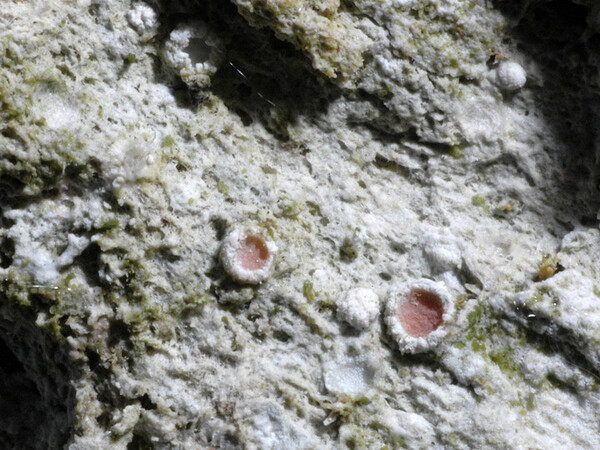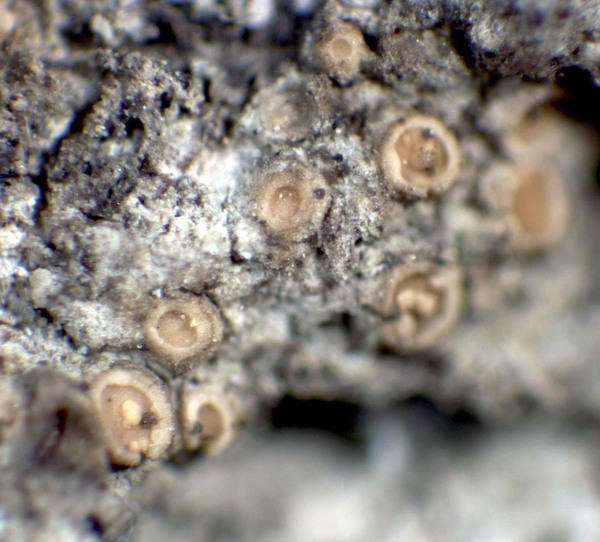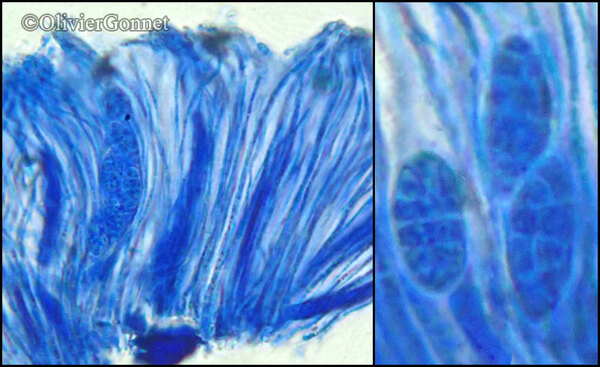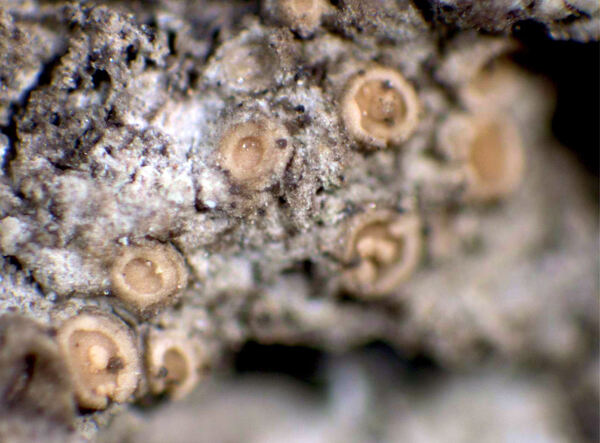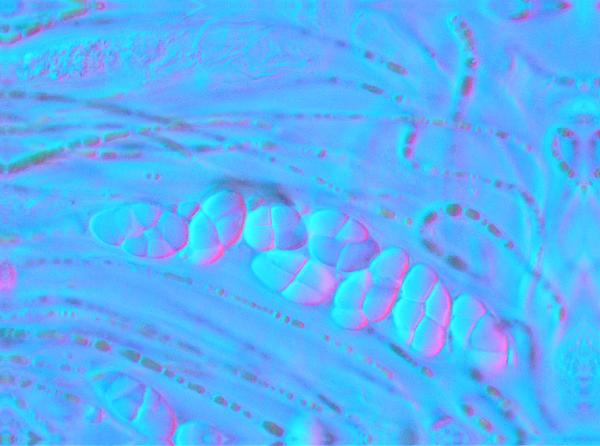Gyalecta flotowii Körb.
Syst. Lich. Germ.: 171, 1855.
Synonyms: Lecidea querceti Nyl.
Distribution: N - TAA (Watson 2014), Lig (Giordani & al. 2002). C - Tosc (Brunialti & Frati 2010), Marc (Frati & al. 2004, Frati & Brunialti 2006), Umb (Ravera & al. 2006, 2006b), Laz (Stofer 2006), Sar. S - Camp (Nimis & Tretiach 2004, Garofalo & al. 2010), Pugl (Nimis & Tretiach 1999), Cal (Puntillo 1996, Incerti & Nimis 2006), Si (Ravera & al. 2024).
Description: Thallus crustose, endosubstratic to thinly episubstratic, usually poorly visible, continuous or faintly cracked, yellowish grey to grey-green, smooth. Apothecia sessile to immersed, 0.2-0.4 mm across, with a concave, pale yellow-ochre to orange disc, and a smooth to slightly crenulate proper margin. Proper exciple colourless, prosoplectenchymatous; epithecium pale orange-brown; hymenium colourless, 85-100
(-115) µm high; paraphyses simple or sparingly branched in upper part, slightly longer than the mature asci, coherent, the apical cells 3-4 µm wide; hypothecium colourless. Asci 8-spored, cylindrical to elongate-subclavate, thin-walled, without tholus, the wall K/I+ blue. Ascospores submuriform (with 3-4 transverse septa and 1-3 longitudinal, oblique septa, up to 6 cells being visible in optical view), hyaline, subglobose to broadly ellipsoid, (9-)10-15(-18) x 6-9(-11) µm. Photobiont trentepohlioid. Spot tests: K-, C-, KC-, P-, UV-. Chemistry: without lichen substances. Note: a mild-temperate lichen found on broad-leaved trees in clearings of ancient, undisturbed forests, especially in deep fissures of the bark, often on Acer and Fraxinus. The species, which however is easy to overlook, is included in the Italian red list of epiphytic lichens as “Near-threatened” (Nascimbene & al. 2013c).
Growth form: Crustose
Substrata: bark
Photobiont: Trentepohlia
Reproductive strategy: mainly sexual
Most common in areas with a humid-warm climate (e.g. most of Tyrrenian Italy)
Commonnes-rarity: (info)
Alpine belt: absent
Subalpine belt: absent
Oromediterranean belt: absent
Montane belt: very rare
Submediterranean belt: extremely rare
Padanian area: absent
Humid submediterranean belt: rare
Humid mediterranean belt: extremely rare
Dry mediterranean belt: absent

Predictive model
Herbarium samples

Ulrich Kirschbaum CC BY-SA 4.0 - Source: https://www.thm.de/lse/ulrich-kirschbaum/flechtenbilder
Central Europe; Germany: Hesse; rare. (Coll/ident Eichler/Cezanne).
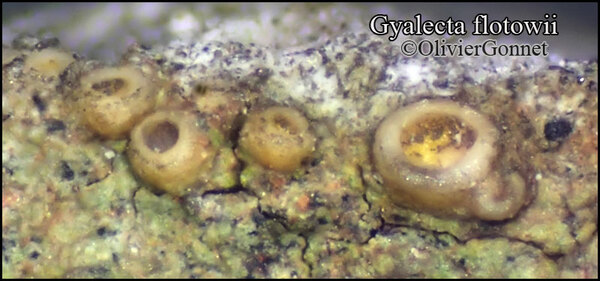
Courtesy Danièle et Olivier Gonnet - Source: https://www.afl-lichenologie.fr/Photos_AFL/Photos_AFL_G/Textes_G1/Gyalecta_flotowii.htm
France, oct. 2015 - sur écorce de Cupressus - Corse
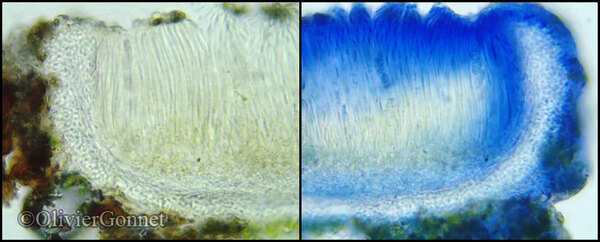
Courtesy Danièle et Olivier Gonnet - Source: https://www.afl-lichenologie.fr/Photos_AFL/Photos_AFL_G/Textes_G1/Gyalecta_flotowii.htm
France, oct. 2015 - sur écorce de Cupressus - Corse
Growth form: Crustose
Substrata: bark
Photobiont: Trentepohlia
Reproductive strategy: mainly sexual
Most common in areas with a humid-warm climate (e.g. most of Tyrrenian Italy)
Commonnes-rarity: (info)
Alpine belt: absent
Subalpine belt: absent
Oromediterranean belt: absent
Montane belt: very rare
Submediterranean belt: extremely rare
Padanian area: absent
Humid submediterranean belt: rare
Humid mediterranean belt: extremely rare
Dry mediterranean belt: absent

Predictive model
| Herbarium samples |

Ulrich Kirschbaum CC BY-SA 4.0 - Source: https://www.thm.de/lse/ulrich-kirschbaum/flechtenbilder
Central Europe; Germany: Hesse; rare. (Coll/ident Eichler/Cezanne).

Courtesy Danièle et Olivier Gonnet - Source: https://www.afl-lichenologie.fr/Photos_AFL/Photos_AFL_G/Textes_G1/Gyalecta_flotowii.htm
France, oct. 2015 - sur écorce de Cupressus - Corse

 INDEX FUNGORUM
INDEX FUNGORUM
 GBIF
GBIF
 DOLICHENS
DOLICHENS
